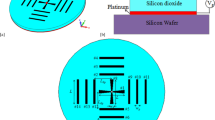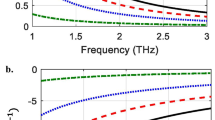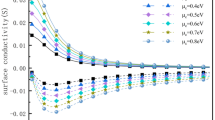Abstract
In this paper, a reconfigurable beam-scanning planar antenna is proposed in terahertz frequencies. The presented structure consists of a semi bow tie antenna surrounded by circularly arranged parasitic pieces of graphene. The performance of the proposed antenna is investigated considering three different states where a PEC ground plane and a graphene ground layer with chemical potentials 0 (mode A) and 1 (mode B) are utilized at the bottom of the substrate. The proposed antenna is designed for utilization at a specific frequency of 1.2 THz in all these three states. The achieved antenna boresight and radiation pattern are altered through changing the conductivity of parasitic graphene elements and ground plane, which is obtained by controlling the corresponding chemical potential of the graphene segments. In addition, the parasitic graphene elements, located around the antenna, provide a high degree of freedom for altering the radiation pattern and antenna boresight. The parasitic elements operate as directors in modes A and B, whereas they act as reflectors in PEC ground state. Moreover, a high beam steering capability is obtained as chemical potentials of graphene elements are allocated between 0 and 1, whereas a PEC ground layer is employed at the bottom of the antenna. It should be noted that the gain and front-to-back ratio of the antenna are controlled using different chemical potentials of the graphene elements. A wide range of scan angles allocated between 0 and 180°, and toward the left and right directions in constant φ plane is achieved for the designed antenna.









Similar content being viewed by others
References
Siegel PH, (2002) Terahertz technology. IEEE Trans on microwave theory and tech. 7, 50, 3:910-928
Cooper DR, D’Anjou B, Ghattamaneni N, et al, (2012) Experimental review of graphene. ISRN Condensed Matter Physics 26
Correas-Serrano D, Gomez-Diaz JS, (2017) Graphene-based antennas for terahertz systems: a review. arXiv:1704.00371
Nourbakhsh M, Zareian-Jahromi E, Basiri R (2019) Ultra-wideband terahertz metamaterial absorber based on snowflake Koch fractal dielectric loaded graphene. Opt Express 27:32958–32969
Arik K, Hemmatyar O, Kavehvash Z (2018) Beam manipulation by hybrid plasmonic-dielectric metasurfaces. Plasmonics 5:1–7
Hanson GW (2008) Dyadic Green’s functions for an anisotropic, nonlocal model of biased graphene. IEEE Trans Antennas Prop 56(3):747–757
Vasko FT, Ryzhii V (2007) Voltage and temperature dependencies of conductivity in gated graphene. Phys Rev B 76(23):233404
Tamagnone M, Gomez-Diaz JS, Mosig JR, Perruisseau-Carrier J (2012) Reconfigurable terahertz plasmonic antenna concept using a graphene stack. Appl Phys Lett 101(21):214102
Esquius-Morote M, Gómez-Dı JS, Perruisseau-Carrier J, (2014) Sinusoidally modulated graphene leaky-wave antenna for electronic beam scanning at THz. IEEE Trans Terahertz Sci and Tech 9, 4, 1:116–22
Xu Z, Dong X, Bornemann J (2014) Design of a reconfigurable MIMO system for THz communications based on graphene antennas. IEEE Trans on Terahertz Sci and Tech 30, 4, 5:609–17
Abadal S, Jornet JM, Llatser I, Cabellos-Aparicio A, Alarcón E, Akyildiz IF (2011) Wireless nanosensor networks using graphene-based nano-antennas. Proc Graphene 2011:1–2
Perruisseau-Carrier J, Skrivervik AK (2008) Monolithic MEMS-based reflectarray cell digitally reconfigurable over a 360 phase range. IEEE Antennas Wire Propag Lett 7:138–141
Hum SV, Okoniewski M, Davies RJ (2005) Realizing an electronically tunable reflectarray using varactor diode-tuned elements. IEEE Micro and Wire Components Lett 31,15, 6:422–424
Chen H, Wu BI, Ran L, Grzegorczyk TM, Kong JA (2006) Controllable left-handed metamaterial and its application to a steerable antenna. Appl Phys Lett 89(5):053509
Novoselov KS, Geim AK, Morozov SV, Jiang D, Zhang Y, Dubonos SV, Grigorieva IV, Firsov AA (2004) Electric field effect in atomically thin carbon films. Science. 306(5696):666–669
Mehta B, Zaghloul M (2013) Tuning nano antenna with graphene. 2013 IEEE Antennas and Propagation Society International Symposium (APSURSI) 130–131
Pinto GS, da Costa KQ (2018) Radiation diagram control of graphene dipoles by chemical potential. 2018 SB Foton International Optics and Photonics Conference (SB Foton IOPC) 1–5
Huang X, Leng T, Hu Z, Liu J, Lu Z, Liu P (2015) Graphene array based beam-scanning terahertz antenna. 2015 IEEE 4th Asia-Pacific Conference on Antennas and Propagation (APCAP) 537-538
Liang F, Yang ZZ, Xie YX, Li H, Zhao D, Wang BZ (2018) Beam-scanning microstrip quasi-Yagi–Uda antenna based on hybrid metal-graphene materials. IEEE Photonics Tech Lett 30(12):1127–1130
Wu Y, Qu M, Jiao L, Liu Y, Ghassemlooy Z, (2016) Graphene-based Yagi-Uda antenna with reconfigurable radiation patterns. AIP Advances 9, 6, 6:065308
Chashmi MJ, Rezaei P, Kiani N (2019) Polarization controlling of multi resonant graphene-based microstrip antenna. Plasmonics 2019:1–10
Depine RA (2017) Graphene optics: electromagnetic solution of canonical. Morgan & Claypool, San Rafael
Author information
Authors and Affiliations
Corresponding author
Additional information
Publisher’s Note
Springer Nature remains neutral with regard to jurisdictional claims in published maps and institutional affiliations.
Rights and permissions
About this article
Cite this article
Basiri, R., Aghazade-Tehrani, M. & Zareian-Jahromi, E. Beam Steering of a Terahertz Semi Bow Tie Antenna Using Parasitic Graphene Ribbons. Plasmonics 15, 1313–1322 (2020). https://doi.org/10.1007/s11468-020-01153-3
Received:
Accepted:
Published:
Issue Date:
DOI: https://doi.org/10.1007/s11468-020-01153-3




